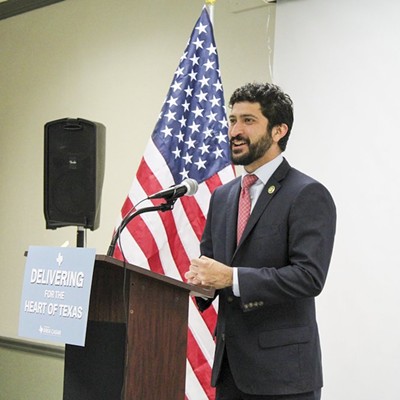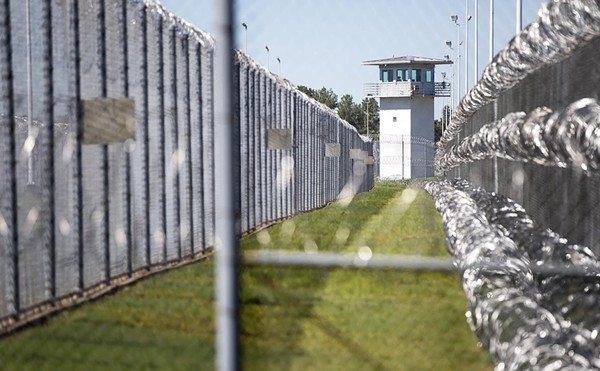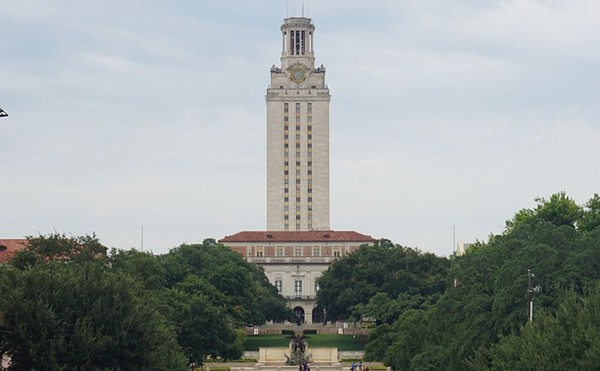It’s been more than two decades since plumes of toxic chemicals were discovered seeping from the former Kelly Air Force Base into the soil and groundwater under the surrounding neighborhoods. More than 20,000 homes sit above these plumes in an area residents have come to call the “Toxic Triangle” because of higher than normal rates of cancer and birth defects.
Residents of the Toxic Triangle who have watched neighbors and family members sicken and die believe those chemicals — primarily trichloroethylene (TCE), a degreasing agent, and tetrachloroethylene (PCE), a paint stripper and dry-cleaning chemical — are the cause of the area’s high incidences of liver, kidney, and other cancers. The official studies have been inconclusive, but two recent developments have led area residents to believe their suspicions were warranted all along.
In March, a Congressional subcommittee released a scathing report criticizing the work of the Agency for Toxic Substances and Disease Registry, the federal agency originally tasked with assessing the health problems near Kelly. Shortly after that report was released, the Current discovered that a cancer expert hired in 2006 to analyze data from the Toxic Triangle was threatened with legal action if he spoke about his results. His report, released to the Current this month by the San Antonio Metropolitan Health District, argues that the Air Force’s toxic legacy may indeed be responsible for some of the neighborhoods’ health problems.
The Air Force dumped TCE and other chemicals used for aircraft maintenance into open pits on the base for decades. In addition to TCE and PCE, Kelly workers also used and dumped dichloroethene (DCE), benzene, vinyl chloride and thalium.
“One former worker admitted he was under orders annually to drain vats of chemicals into the ground during the Christmas holidays,” reported the Express-News in 2006. Toxic Triangle resident Yolanda Johnson told the LA Times in 2006 that those chemicals periodically flooded the area during heavy rainstorms, sending the overflow through surrounding streets that lacked storm drains. In the same article, local hydrologist George Rice said it was known that people in the neighborhood had used shallow wells, dug illegally, for drinking water, gardening, and washing cars. The Air Force has capped some 75 such wells.
When San Antonio Metro Health commissioned a study of liver cancer in southwest San Antonio in 2006, the Texas Cancer Registry provided data confirming 319 cases of liver cancer in the 14 ZIP code study area near Kelly between 1995-2003, versus 381 cases in Bexar County’s 61 other ZIP codes. Male liver-cancer death rates were found to be “significantly higher than expected” in three of the studied ZIP codes. The Texas Department of State Health Services has found elevations of birth abnormalities in the area such as Down syndrome and lung defects, while ATSDR has reported elevated rates of lung and kidney cancer, as well as leukemia.
“We call ourselves the living dead, because we know our time is coming because of the plumes that were there,” says 67-year-old Toxic Triangle resident Robert Alvarado, who is on a list for a kidney transplant, and is almost blind due to an aneurysm. His wife and one of his daughters were treated for thyroid cancer, while his cousin Mary Lou Ornelas, who worked at the base for 18 years, developed liver cancer and died in 2006 at age 59.
Alvarado and his family have lived in the predominantly Mexican-American neighborhood for almost 40 years. It’s an area where many of the ’50s-era houses appear somewhat dilapidated, while others may be modest but are well-kept. Poverty is high. Per-capita income for District 5, where much of the Toxic Triangle sits, was projected by the Westside Development Corporation to be less than $11,000 in 2008.
Working with the non-profit Southwest Workers Union, Alvarado helped found a group called the Committee for Environmental Justice Action. To highlight the extent of the area’s health problems, they distributed purple crosses to homes where at least one family member had been diagnosed with cancer. They chose purple, Alvarado says, so that the crosses would stand out in the yards. In 2006, the Current reported that SWU members had knocked on 350 doors in the triangle; half of those homes qualified for a purple cross.
Agencies in charge of the base’s cleanup tend to speak and act as if the situation is nearing resolution, despite the community’s continuing health problems and accompanying decline in property values. Since 1999, the Air Force has spent $320 million on Kelly cleanup, including the installation of underground barriers and a pump-and-treat system to flush contaminants.
“The plumes are slowly shrinking, and the remedies are in place,” said the Environmental Protection Agency’s Gary Miller at an April 15 public meeting.
But as the plumes diminish, so does the possibility of linking the area’s illnesses to Kelly’s chemical trail. ATSDR conducted studies in the ’90s that acknowledged increased levels of liver and kidney cancer, as well as leukemia, among the area’s residents, but none of those studies connected the illnesses with the chemical plumes. The EPA recently conducted two rounds of indoor vapor testing in 29 total homes in the Toxic Triangle, to address concerns that gases from the plumes might pose a threat. But Miller reported in mid-April that the second round of February tests, like an initial round conducted last May, did not find significant exposure levels.
While the EPA was brought in to conduct the vapor tests, the Texas Commission on Environmental Quality has been in charge of monitoring the Kelly cleanup, because despite the extent of the contamination, the base has never been declared a federal Superfund site. Such a designation would have enabled citizens to hire outside experts of their choosing to study the situation through the EPA’s Technical Assistance Grants.
EPA press officer Dave Bary says the EPA didn’t designate Kelly a Superfund site because it was “not an abandoned site, like virtually all Superfund sites are.” The active Hill AFB in Utah is a Superfund site, however, as is Camp Lejeune in North Carolina. SWU filed a federal civil-rights complaint in 1999 alleging that failing to classify Kelly as a Superfund site constituted a civil-rights violation against the Mexican-American communities surrounding the base. The Lone Star chapter of the Sierra Club later joined SWU in filing a petition with the EPA and then-Governor George W. Bush to designate Kelly a Superfund site, but the campaign failed.
A troubling military legacy
The problems that plague San Antonio’s Toxic Triangle are just one example of the military’s considerable environmental liability. The Associated Press reported in 2007 that the EPA is overseeing cleanups of TCE and PCE at more than 150 military installations, including the Camp Lejeune marine base in North Carolina, where contamination of the base’s tap water exposed residents to the chemicals. The AP reported that 850 former residents of Camp Lejeune are seeking $4 billion in damages, which comes out to about $4.7 million per person.
Retired Marine Master Sgt. Jerry Ensminger lost a 9-year-old daughter who was conceived at Camp Lejeune to leukemia he believes was caused by the base’s water. He says the dollar figures at stake make it easy to see why Uncle Sam has been stonewalling efforts to connect the contamination at such sites to neighboring health problems.
“It’s one of the reasons the Department of Defense is throwing so many assets at this thing,” said Ensminger. “When you’re fighting a government agency who is the defendant … they’ve got all the financial assets of all the taxpayers in the United States. They’re using the taxpayers’ money as weapons against us.”
Camp Lejeune’s plaintiffs have been stalled in their tracks for the past two years. A June 2007 Government Accountability Office investigation reported that the Navy Judge Advocate General was waiting to rule on the claims until the office received a report from ATSDR regarding how the water affected babies in utero. The GAO said the ATSDR report was expected by the end of 2007, but ATSDR has yet to deliver its findings.
Ensminger recently visited Robert Alvarado and the Toxic Triangle for a documentary being filmed about the environmental contamination of communities caused by military
activities.
“For the life of me, I don’t know how the Air Force got away with `Kelly` not being declared a Superfund site,” Ensminger said.
Conflicts of interest
In mid-March, Congress released a report harshly criticizing ATSDR for its shoddy analytical work. It cited Kelly AFB and Camp Lejeune among 10 prime examples.
“The Subcommittee has heard from many sources examples of jackleg science by ATSDR and their keenness to please industries and government agencies that prefer to minimize
public health consequence,” said Chairman Brad Miller (D-NC) when his
Committee on Science and Technology released its extensive indictment.
The report says ATSDR “often obscures or overlooks potential health hazards, uses inadequate analysis, and fails to zero in on toxic culprits,” and that, “Time and time again, ATSDR appears to avoid clearly and directly confronting the most obvious toxic culprits that harm the health of local communities throughout the nation.”
The section on Kelly features criticism by University of Maryland toxicologist Dr. Katherine Squibb, who reviewed ATSDR’s work in 2000 and 2002 after being hired by the Technical Review Committee of the Kelly Restoration Advisory Board. Squibb found that ATSDR’s analysis at Kelly was based on minimal information, that some Air Force studies ATSDR relied on for its conclusions failed to measure important exposure pathways, and that ATSDR failed to adequately assess whether some chemicals migrated off base.
“It is questionable as to whether ATSDR’s conclusion that no public exposure to contaminants occurred through domestic use of groundwater in the past is correct,” wrote Squibb. She also concluded that ATSDR had examined health risks from exposure to soil from a part of the base only after it had been cleaned up.
A 2001 ATSDR report again acknowledged high rates of cancer in the Kelly area, but did not attribute them to the plumes. When questioned in February 2009 about possible alternate causes for the neighborhoods’ health issues, ATSDR said that since they were no longer active at the base they would have to defer the question to TCEQ. TCEQ, in turn, said they couldn’t speak for ATSDR.
David Fowler, ATSDR’s lead health assessor for its Kelly study, issued a statement in early March saying that it is “unlikely” that groundwater contamination is responsible for the Toxic Triangle’s cancer cluster since the plumes were just beginning to move off base at the time of its initial investigation in 1996, and because the contaminated aquifer was not a source of drinking water.
But Squibb says ATSDR’s conclusions about the groundwater near Kelly were based on weak data.
“`The chemicals` got into the groundwater initially on base where they were being dumped, and then it takes a while for the chemicals to move and spread out in the groundwater. So they were going by data that supposedly said, OK, we’ve tested off base and we didn’t find them earlier, but now we’re just finding them near the base line, so they’re just now moving off base and therefore they weren’t there before. But if you go back to that reference, the data that ATSDR used … that was not a very good, comprehensive study. So maybe it hadn’t moved off base in that area yet, but it may have moved off base in other areas.”
Squibb said ATSDR’s problems are part of a broken system.
“If we’re going to fix this, we need to fix the system,” said Squibb. “If you read through their reports, a lot of times they’ll say there’s not enough information to make a decision … and that’s where there’s a real failure of follow-up.”
San Antonio Metro Health’s studies show that the agency has relied on ATSDR’s research as a foundation for much of its own work in the area. Yet, in mid-April, Metro Health Director Dr. Fernando Guerra admitted that he hadn’t yet read the 33-page Congressional report.
Guerra suggests that preexisting conditions, such as cirrhosis, and lifestyle choices such as tobacco use and diet, are responsible for the Toxic Triangle’s high rate of liver cancer. “What I can say with fairly good evidence is that there seems to be a background rate `of illnesses` that perhaps indicates some prior exposure…. or risk-taking behavior,” said Guerra.
But hydrologist George Rice, a former Kelly Restoration Advisory Board member and current Edwards Aquifer Authority board member, says Guerra has consistently downplayed any potential link between Kelly and the neighborhoods’ health issues.
“Dr. Guerra would always be brought in to pooh-pooh that stuff,” said Rice, who served on the Kelly RAB from 1994-2004. “I don’t have a lot of faith in Metro Health when it comes to Kelly.”
“I doubt that EPA, TCEQ, or Metro Health will give much attention to the new Congressional report,” said Southwest Workers Union Environmental Justice Coordinator Lara Cushing the week before Guerra was interviewed. “They’ve made up their mind on this community long ago.”
A buried report
San Antonio Metro Health hired Maryland-based contractor HealthCare Resolution Services to conduct its 2006-07 liver-cancer study in the 14 ZIP code area adjacent to Kelly. Cancer cluster expert Tim Aldrich from East Tennessee State University was hired by HCRS to lead the study.
Aldrich seemed eminently qualified, with a Ph.D. in Epidemiology from the University of Texas and minors in Biostatistics and Environmental Health. He’s been widely published by various journals and medical associations during the past decade.
Aldrich’s analysis suggested that even after weighing all other potential factors — such as lifestyle and genetics — 36 known cancer cases remained unaccounted for.
“This study found conspicuous evidence of clustering of communities with elevated liver cancer rates nearby to the former Kelly AFB … 11.5 percent of the local area cases may be attributable to residing over the Kelly PCE plume,” Aldrich’s report says, recommending that “further research of the liver cancer risk in Bexar County is justified and feasible.”
But the community never saw Aldrich’s conclusions. The Express-News reported in 2007 that Aldrich’s study was “quietly released” to city council but that a planned meeting to announce the results to those living in the affected neighborhoods was never held.
Metro Health subsequently convened a “blue ribbon” panel to review Aldrich’s report, which was promptly discredited and never published.
The panel determined that “of particular concern as an outcome of this report was its discussion of attributable risk. The panel felt that this study, as presented, could not accurately conclude anything about attributable risk.” The panel also took the report to task for lacking critical information such as a description of the chemicals that left the base and which ZIP codes were affected.
But Aldrich says he is not allowed to defend or explain his report because Metro Health contractor HealthCare Resolution Services has threatened him with a breach-of-contract lawsuit if he discusses his research with the media or publishes the report. When the Current contacted Aldrich to request an interview, he said he was required to direct such inquiries to either Dr. Guerra or HCRS President Brenda Doles, who happens to be a co-preparer of Aldrich’s report.
Dr. Guerra and other Metro Health officials denied knowledge of the alleged lawsuit threat.
Meanwhile, Metro Health’s “blue ribbon” panel contains two significant flaws of its own. The panel was composed of four prestigious sounding professors, but the chair of the panel, Dr. Arthur Frank from Drexel University, admitted to a possible conflict of interest.
“The only notable potential conflict of interest was that Dr. Frank has an adjunct academic appointment at the School of Aerospace Medicine at the Air Force facilities in San Antonio, and has worked with the Air Force on occupational medicine residency activities,” says the panel’s review. “This was shared with the group, and is therefore noted in this report.”
Metro Health Public Relations Manager Christine Patmon says Frank is a top-notch scientist involved in many projects, “as most scientists are,” and that since he declared his potential conflict, Metro Health did not consider it an issue.
Patmon says Metro Health put together the panel with the assistance of physician consultant Dr. James Wittmer. Wittmer happens to be a fellow of the Aerospace Medical Association. The ASMA has no official affiliation with the Air Force, but many of its members are current or former Air Force employees.
“They got their own people to do the investigation,” said Robert Alvarado. “We’ll never get out of the circle with the same information. It’s a dog and pony show.”
The panel further recommended that “while an epidemiological study would be potentially feasible, it would be a massive undertaking and extremely expensive.” They instead suggested that “other ongoing scientific investigations that might shed light on this overall issue” should be pursued. These included estimating the rate of hepatitis in the area, as well as “a study of possible aflatoxin contamination of corn used to make dietary items in the Hispanic population (e.g. tortillas.)”
Aflatoxin is a toxic mold that can grow on corn and other crops. Documentation of such exposure, however, has most commonly been observed in agricultural and developing economies. SWU Environmental Justice Coordinator Lara Cushing says the community was disgusted by the aflatoxin theory. SWU handed out popcorn and “toxic” Kool-aid in protest at the meeting where Metro Health announced the aflatoxin study by Texas A&M.
“We brought our concerns to Dr. Guerra, who agreed to meet with us but then never did,” said Cushing. “We found it particularly outrageous that cancer patients were being asked to further the research goals of a scientist with money that could have been spent on cleanup or health care for community members.”
Metro Health officials insist that Aldrich’s research was flawed and that the agency had no desire to withhold anything from the community.
“`Aldrich’s` info was of concern because it wasn’t jiving with what we already had from the state,” said Guerra. “It was clear that he exceeded what he was meant to have done and there was concern about methodology.”
Guerra says that Metro Health’s standard contract reserves the right not to publish reports it commissions. He deferred the Aldrich issue to HCRS. HCRS’s Doles refused to address Aldrich’s allegation.
“You’re barking up the wrong tree,” Doles said. Asked point blank if she would confirm or deny that she personally had threatened Aldrich with legal action if he speaks about his Toxic Triangle research, Doles issued a “no comment” and said, “I can only refer you back to the City of San Antonio.”
The “blue ribbon” panel’s conflicts of interest pale in comparison to those of HCRS, a Maryland-based company that has boasted of its “roster of Air Force clientele.” When Doles was recognized in 2006 as one of the Washington Business Journal’s “Women Who Mean Business,” a press release indicated that HCRS’s revenues had “skyrocketed” to $7.4 million in 2004, $12 million in 2005 and a projected $20 million in 2006 “thanks to successfully fulfilling numerous government contracts, including several high-profile ones in the military.”
Austin-based environmental attorney Rick Lowerre, who represented SWU’s Committee for Environmental Justice Action when they requested a contested case hearing over Kelly’s closure plans in 1998, says the situation with Aldrich is very unusual. Lowerre says Aldrich’s research could be used by a trial lawyer to convince a jury that Toxic-Triangle residents are at increased risk for cancer due to the plumes from the base, and that the Air Force should pay for the community’s health problems.
U.S. Representative Charlie Gonzalez has helped earmark money over the years for Metro Health’s Public Center for Environmental Health to attempt to assess and treat the health issues in the region. But he doesn’t seem troubled about Metro Health’s decision to bury the Aldrich report.
“Neither you nor I can in any way modify `a` contract that we have nothing to do with,” said Gonzalez. He said he felt Metro Health was being forthcoming by sending the Current a copy of Aldrich’s report.
As the cleanup around Kelly proceeds, the beleaguered community feels time is running out to prove that the Toxic Triangle’s health problems were caused at least in part by the Air Force’s negligence. The base is in the process of being privatized as the Port San Antonio industrial park, and when the cleanup is deemed finished, the Air Force will be able to wash its hands of its toxic legacy at Kelly.
“The Air Force wants to walk away from Kelly by the end of next year and leave behind highly contaminated soils and water, cleanup procedures expected to take decades, and a contaminated Leon Creek,” said SWU’s Cushing. “Failing to connect the cancer epidemic to the contamination essentially lets the Air Force get away with murder, because without this missing link the Department of Defense is never held to account for the suffering of workers and the community.” •
Military campaign
San Antonio’s Toxic Triangle is not the only community dealing with the environmental fallout from former military operations. Including these sites, the EPA is supervising the cleanup of TCE and PCE contamination at more than 150 military installations.
Camp Lejeune Marine Corps Base, Camp Lejeune, NC: TCE and PCE contaminated the base’s tap water and 850 former residents have filed suit for $4 billion in damages. The Navy’s Judge Advocate General is still awaiting an ATSDR report due at the end of 2007 before ruling on whether the claims have a basis.
El Toro Marine Corps Air Station, Santa Ana, CA: Closed in 1999 after a TCE plume spread into Orange County for 20 years without base vets being notified of potential exposure. The Superfund site is also contaminated with radionuclides from Radium 226, which was used to create fluorescent aircraft instruments.
Tucson International Airport Area, Tuscon, AZ: This Superfund site had a 50-year history of contamination dating to military contractors dumping TCE during and after the Korean War. The TCE plume contaminates groundwater to this day.
The Industrial Excess Landfill, Uniontown, OH: Citizens allege the Army secretly dumped Cold War weapons waste in the late ’60s, and fear it threatens the area’s water supply. The EPA convened a “blue ribbon” Scientific Advisory Board in 1994 to assess the Superfund site, including questions about radiation. The panel ruled there was no such concern, yet when queried in 2006, a majority admitted they weren’t qualified to assess radiation issues or had not contributed to the assessment.


















